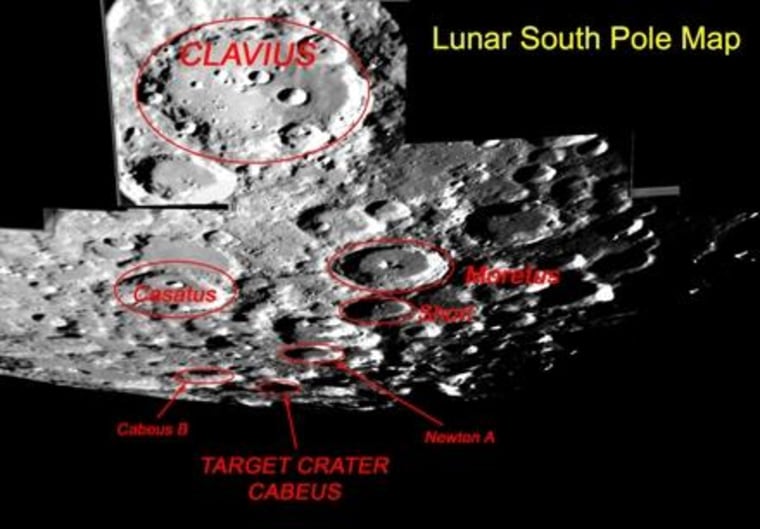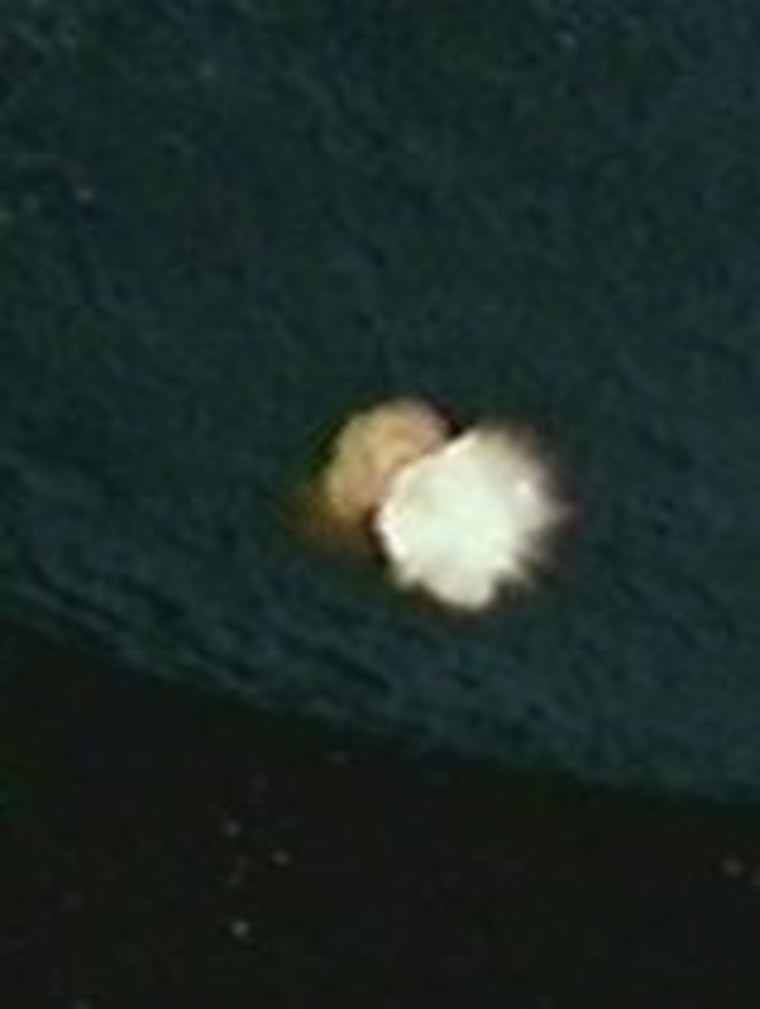Get ready for a unique cosmic collision! Early Friday morning, NASA's Lunar Crater Observation and Sensing Satellite will end its mission with a bang — literally.
The probe — also known by its acronym, LCROSS — is currently carrying along the upper stage of the rocket that launched it on its way to the moon on June 18. NASA's game plan is to send that spent rocket motor on a course to smash into the lunar surface. Not just anywhere on the lunar surface, but to a thoroughly scrutinized crater called Cabeus that lies near the moon's south pole and is enveloped in perpetual darkness. The hoped-for result will be to find hidden water frozen inside the crater.
For seasoned skywatchers here on Earth, the event should also produce a visible cloud of ejected material. However, only knowledgeable amateur astronomers with the right equipment will be able to detect the event. Others can watch the event live on NASA TV.
Smackdown!
The general belief among astronomers is that over the last few billion years, the moon has been bombarded by countless numbers of comets. The water from most of these comets completely sublimated away, but if any settled at the bottom of a crater near the moon's poles, those permanently shadowed regions can keep the water from disappearing and lock it up as ice for a very long time.
Cabeus is a relatively flat crater about 60 miles (100 kilometers) in diameter on the moon's south pole. Scientists believe the crater may be one of those special cases that holds water ice in its perpetually shadowed top soil. NASA initially selected a different target for LCROSS, the nearby crater of Cabeus A, but switched to the larger Cabeus because data suggested it had a higher likelihood of containing hidden water ice.
The impact is scheduled to occur this Friday, Oct. 9, at 7:30 a.m. ET. That's 4:30 a.m. PT, or 11:30 UT. To convert Universal Time to your local time, go here.
Impact will occur less than 10 hours after the spent Centaur rocket motor is released and the LCROSS "shepherding spacecraft" maneuvers into position to trail the Centaur en route to the lunar surface. The 5,000-pound (2,270-kilogram) Centaur is expected to slam into Cabeus at a sharp angle at a speed of 5,600 mph (9,000 kilometers per hour).

If all goes according to schedule, the shepherding vehicle, carrying nine science payloads, will follow the Centaur's plunge into the moon, beaming back data live to Earth. Like a bullet hitting sand, the Centaur stage's explosive collision is expected to create a crater roughly 60 or 70 feet wide (20 meters wide) and perhaps as much as 16 feet (5 meters) deep, in the process dredging up approximately 385 tons of lunar dust and soil — enough to fill nearly 18 school buses. In addition to recording the collision, the shepherding spacecraft will fly through the regolith plume thrown up by the collision, just before it too slams into the lunar surface some four minutes later, kicking up its own smaller plume of debris.
In the minutes leading up to its sacrifice to the cause of science, the 1,500-pound (700-kilogram) shepherding spacecraft will use its specialized sensors to look for water's telltale chemical signature within the larger debris plume created by the Centaur, possibly in the form of ice, hydrocarbons or hydrated materials.
How to watch
NASA wants amateur astronomers to join in a "citizen scientist" program. Jennifer Heldmann heads the LCROSS observing campaign. "We would like to have as many eyes and instruments watching the impact as possible, because this is the way we'll get the most data and the most information as possible," she said.
Those who live to the west of Mississippi River will have the best opportunity, because the sky will still be dark. Those living east of the Mississippi will still be able to see the moon, but they'll also have to contend with morning twilight or, in the case of those living along the Atlantic Seaboard, daylight after sunrise. That makes for a much brighter sky background.
To see LCROSS' effect, a dark backdrop will be an important prerequisite, since it's estimated that the debris plume will be no brighter than a sixth-magnitude star (the threshold of naked-eye visibility), and quite likely even fainter.
If you want to try seeing the impact yourself, you need to be aware of some important points.
The bigger, the better
First, you're going to need a moderately large telescope, somewhere on the order of at least 10 to 12 inches (250mm to 300mm) of aperture. Smaller telescopes will probably not be able to do the job, and you will definitely not see anything using binoculars. You'll likely need to use magnifications in the 250- to 500-power range to have a legitimate chance of getting a glimpse of the dim impact plume.
Keep in mind that high power dilutes the brightness of an image, and aggravates any unsteadiness of detail. As a general rule of thumb, the maximum amount of magnification for any telescope should be 50-power per inch of aperture.
"But wait a minute," you may protest, "my telescope comes with a special Barlow lens that the manufacturer promises will double or even triple the magnification of my eyepiece."
True enough. In fact, that aforementioned 500-power is likely achieved by pushing the scope's highest power eyepiece with that very same Barlow lens, which ultimately will result in a dim, impossibly fuzzy image.
If you're a beginner, you need to understand that that using a Barlow lens is similar to enlarging a photograph. The negative, like a telescope's image, contains only so much detail, which can be blown up only so far before all you can see is fuzz! So if you have a 3-inch (75mm) department store telescope — even if it is blessed with perfect optics — the claim of 500-power is more than three times the limit of the most practical magnification that it can provide.

The impact will take place at the lunar south pole, or on the lower limb of the moon along the dark portion immediately adjacent to the terminator (the line that separates the illuminated day side and the dark night side of the Moon). Try to keep the very bright sunlit portion of the moon out of the field of view as much as possible.
The plume is expected to be in the shape of a "Vm" but it will be exceedingly small in size relative to the moon itself. According to NASA's Brian H. Day, the dusty material is only expected to rise about 6 miles (10 kilometers) above the lunar surface. From Earth, that would be equal to about one-quarter of 1 percent of the moon's apparent size or about 5.2 arc seconds.
To get an idea of just how large this is, point your telescope toward Jupiter, which conveniently shines in the southern part of our current evening sky. Jupiter's disk currently measures 45 arc seconds in diameter; so the dust plume from LCROSS would appear only about one-ninth as large as that!
And the plume — if and when it's visible — will not last very long. The best guesstimates are that it will last no more than two minutes.
You can get more detailed viewing tips from NASA here.
Observatories expected to participate in the study include the newly refurbished Hubble Space Telescope, Hawaii's Keck and Gemini telescopes, the Magdelena Ridge and Apache Ridge observatories in New Mexico, the MMT Observatory in Arizona and the Lunar Reconnaissance Orbiter (LRO) now circling the moon.
Lastly, you can watch the event live on NASA TV, beginning at 6:30 a.m. ET (3:30 a.m. PT).
More on LCROSS | backyard telescopes